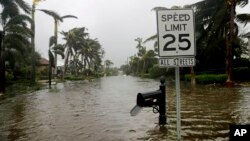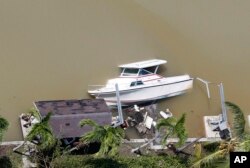Residents of the Florida Keys may be unable to go home for weeks, to see for themselves the havoc left by Hurricane Irma.
The Keys were the first part of Florida slammed by the powerful hurricane Sunday morning. Irma's winds and storm surges swept over the island chain, wrecked roads and bridges and swept homes and cars aside.
What was left after the storm passed is “not fit for re-entry for regular citizenry for weeks,” according to the White House homeland security adviser, Thomas Bossert.
The Keys, an archipelago of hundreds of low-lying islands, stretch 265 kilometers (165 miles) from mainland Florida into the Gulf of Mexico. One main highway travels from the mainland to Key West, a famous tourist destination that is the southernmost part of the United States. Many of the scores of bridges that carry the road from island to island were badly damaged in the storm, Bossert said, and almost all of the inhabited islands now have no power, no water supply and no telephone service.
The Navy has sent three ships to help with rescue and recovery efforts, which will include searches of wrecked homes that may contain the remains of storm victims.
“My heart goes out to the people in the Keys,” the state's governor, Rick Scott, said Monday after flying over the islands. “There's devastation. ... I just hope everybody, you know, survived. It's horrible what we saw.”
65 percent of Florida without power
Safety inspections for all bridges are a top priority, Scott said. And although the storm has passed, he asked all of Florida's more than 20 million residents not to leave their homes or shelters for the time being. Electrical lines are down everywhere across Florida, and streets are covered with all kinds of debris — parts of buildings, trees, furniture, abandoned cars and boats.
Sixty-five percent of the state is without power. Scott said an armada of electrical utility workers — 23,000 from Florida and thousands more from other states — is working to restore service, but some residents must be prepared for outages lasting weeks.
The National Hurricane Center warned that swells along the southeastern U.S. coast could still cause “life-threatening surf and rip current conditions.”
Satellite images:
69 tornado warnings
Irma, whose winds are now well below hurricane strength, was moving across southwestern Georgia and parts of Alabama late Monday, but still setting meteorological precedents.
Atlanta, Georgia, was under a tropical storm warning for the first time ever. And since Sunday Florida has recorded 69 tornado warnings, more than ever before in a two-day period.
Jacksonville, Florida's largest city by population, also is the biggest city in the country in area, and much of it was covered by water Monday — the biggest flood in Jacksonville since 1864, when Abraham Lincoln was president and Florida was part of the confederacy fighting in the American Civil War.
Photos: The Aftermath of Hurricane Irma
Florida declared a major disaster area
Irma was the strongest Atlantic storm ever recorded and an unusually large tropical cyclone, with strong winds extending hundreds of kilometers out from its center. Even before the hurricane finished its course through the state, President Donald Trump declared Florida a major disaster area and ordered the release of federal aid funds to help storm victims.
Still, Governor Scott and other state officials said they were relieved that overall damage was less severe than the devastation Irma spread late last week across the eastern Caribbean, where the death toll has reached 25.
Dutch King Willem-Alexander flew to St. Maarten, the Netherlands' tiny Caribbean territory, and French President Emmanuel Macron is heading to his country's adjoining St. Martin territory. Prime Minister Gaston Browne of Antigua and Barbuda said 95 percent of Barbuda's buildings were destroyed or severely damaged.
The State Department said Monday that U.S. embassies and consulates have reopened in the Dominican Republic, Haiti, the Bahamas, Barbados and Curaçao, although services were limited.
The power grid in the U.S. territory of Puerto Rico was so badly damaged that repairs could take months, authorities on the island said. More than one million residents have no power.
Steve Herman contributed to this report.












